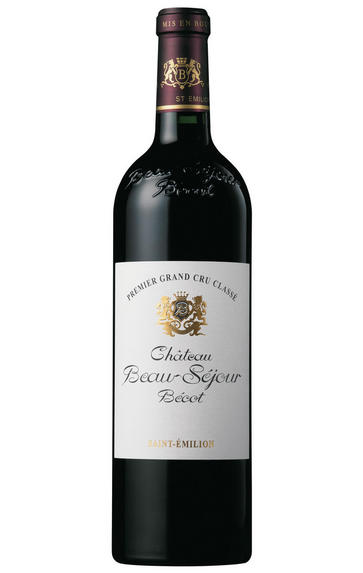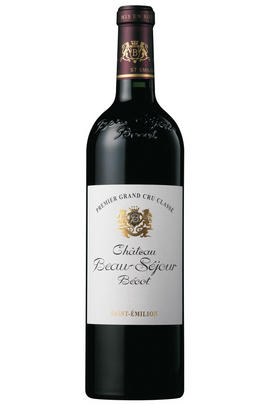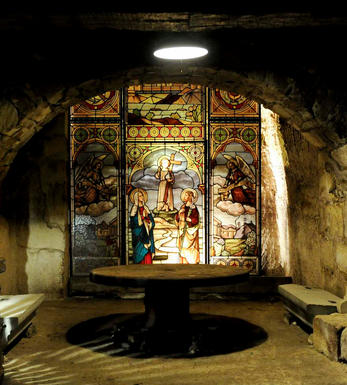
2021 Château Beau-Séjour Bécot, St Emilion, Bordeaux

Critics reviews
The 2021 Beau-Séjour-Bécot was picked September 21 to October 15, almost a whole month, with crews working half-days to pick at optimal maturity in each parcel. Yields were 33hL/ha, and the wine matured in 55% new oak, 25% amphora and 20% used barrels for a planned 16 months. Tasted twice; the first sample was a bit bashful, but the bottle poured at the château was much better. It has a mixture of red and black fruit, dried rose petal, bergamot and a touch of chalk. The palate is medium-bodied with fine definition, a fine level of acidity (pH 3.5) and mineral-laden red fruit. It shows fine transparency and appreciable energy and tension. 13.2% alcohol
Neal Martin, vinous.com, (May 2022)
The 2021 Beau-Séjour-Bécot is one of the most elegant wines I have ever tasted here. Pliant and deep, with striking depth, the 2021 is outrageously beautiful. All the elements come together so effortlessly. Dark fruit, mocha, spice, licorice and incense all build in the glass. The creamy tannins are impossibly refined for the year, while the finish is eternal. The 2021 is a real stunner. Readers won't want to miss it!
Drink 2031 - 2061
Antonio Galloni, vinous.com (May 2022)
Fragrant red-berry aroma and flavour. Mid-palate fruit and freshness, the chalky terroir evident but not overpowering. Fine grain of tannin. Clean, dry finish. Very much the new style.
Drink 2028 - 2038
James Lawther, jancisrobinson.com (May 2022)
Aromas of deep berry fruit, dark chocolate, subtle spices and dried flowers introduce the 2021 Beau-Séjour Bécot, a medium to full-bodied, velvety and seamless wine that's lively and layered, with a deep core of fruit, ripe tannins and a long, saline finish. Cropped at 35 hectoliters per hectare, and based on Merlot with some 13% Cabernet Franc and 2% Cabernet Sauvignon in a supporting role, its quality reflects a growing season of relentless efforts and the impact of extra sorting equipment rented on the eve of harvest.
William Kelley, Wine Advocate (Apr 2022)
Lots of blue fruit with violets and a hint of boysenberry. Medium body, integrated and fine tannins and a cool, linear finish. Solid length and brightness.
James Suckling, jamessuckling.com (May 2022)
About this WINE

Château Beau-Séjour Bécot
Château Beau-Séjour Bécot has experienced some dramatic ups and downs in recent decades: it was classified a Premier Grand Cru Classé B in 1955, demoted in 1986 and promoted once again, as a Premier Grand Cru Classé B, in 1996.
The terroir is outstanding, most of it atop the limestone plateau. Juliette Bécot and husband Julien Barthe represent the third generation of Juliette’s family here, along with her cousins Pierre and Caroline Bécot. Not so long ago, the wines were turbo-charged and Parker-friendly, ripe with lots of new oak and extraction. Under Juliette and Julien’s guidance, there has been a major turnaround stylistically. Thomas Duclos consults here, having taken over from Michel Rolland.

St Émilion
St Émilion is one of Bordeaux's largest producing appellations, producing more wine than Listrac, Moulis, St Estèphe, Pauillac, St Julien and Margaux put together. St Emilion has been producing wine for longer than the Médoc but its lack of accessibility to Bordeaux's port and market-restricted exports to mainland Europe meant the region initially did not enjoy the commercial success that funded the great châteaux of the Left Bank.
St Émilion itself is the prettiest of Bordeaux's wine towns, perched on top of the steep limestone slopes upon which many of the region's finest vineyards are situated. However, more than half of the appellation's vineyards lie on the plain between the town and the Dordogne River on sandy, alluvial soils with a sprinkling of gravel.
Further diversity is added by a small, complex gravel bed to the north-east of the region on the border with Pomerol. Atypically for St Émilion, this allows Cabernet Franc and, to a lesser extent, Cabernet Sauvignon to prosper and defines the personality of the great wines such as Ch. Cheval Blanc.
In the early 1990s there was an explosion of experimentation and evolution, leading to the rise of the garagistes, producers of deeply-concentrated wines made in very small quantities and offered at high prices. The appellation is also surrounded by four satellite appellations, Montagne, Lussac, Puisseguin and St. Georges, which enjoy a family similarity but not the complexity of the best wines.
St Émilion was first officially classified in 1954, and is the most meritocratic classification system in Bordeaux, as it is regularly amended. The most recent revision of the classification was in 2012

Merlot/Cabernet Franc
Merlot and Cabernet Franc are grape varieties commonly used in Bordeaux-style blends, particularly in the Bordeaux region of France. When these two grapes are blended, they can create a wine that combines the best characteristics of each variety.
Merlot is known for its smoothness, soft tannins, and ripe fruit flavours. It often contributes black cherry, plum, and chocolate flavours to the blend. The grapes are relatively easy to grow and ripen earlier than other Bordeaux varieties, making them versatile for blending.
Cabernet Franc, on the other hand, adds structure, depth, and complexity to the blend. It typically brings aromas of red fruits such as raspberry and strawberry, along with herbal notes like bell pepper and tobacco. These grapes have thinner skins and can be more challenging to cultivate, requiring specific growing conditions to reach their full potential.
When Merlot and Cabernet Franc are combined, the result is a well-balanced wine with various flavours and aromas. The blend often exhibits a Bordeaux wine's medium to full body, along with a smooth texture and moderate tannins. The specific flavour profile can vary depending on the proportions of each grape in the blend and the terroir and winemaking techniques employed.


Buying options
Add to wishlist
Description
Merlot 85%, Cabernet Franc 13%, Cabernet Sauvignon 2%
Mildew was a challenge for Juliette Bécot and husband Julien, but their core vineyard team lives on-site so could manage it with constant supervision. The harvest lasted nearly a month, the team waiting for each plot to ripen perfectly. The winemaking leans towards non-intervention; the wine is aged in amphorae (20%) and barriques. It always seems to have a free-flowing style, understated yet building to a loose-limbed intensity. Wonderfully nuanced floral rose notes are underpinned by a cool iodine minerality. This is composed and elegant with a finish that grows in expression. Drink 2026-2042.
Our score: 17.5/20
Berry Bros. & Rudd, April 2022
wine at a glance
Delivery and quality guarantee